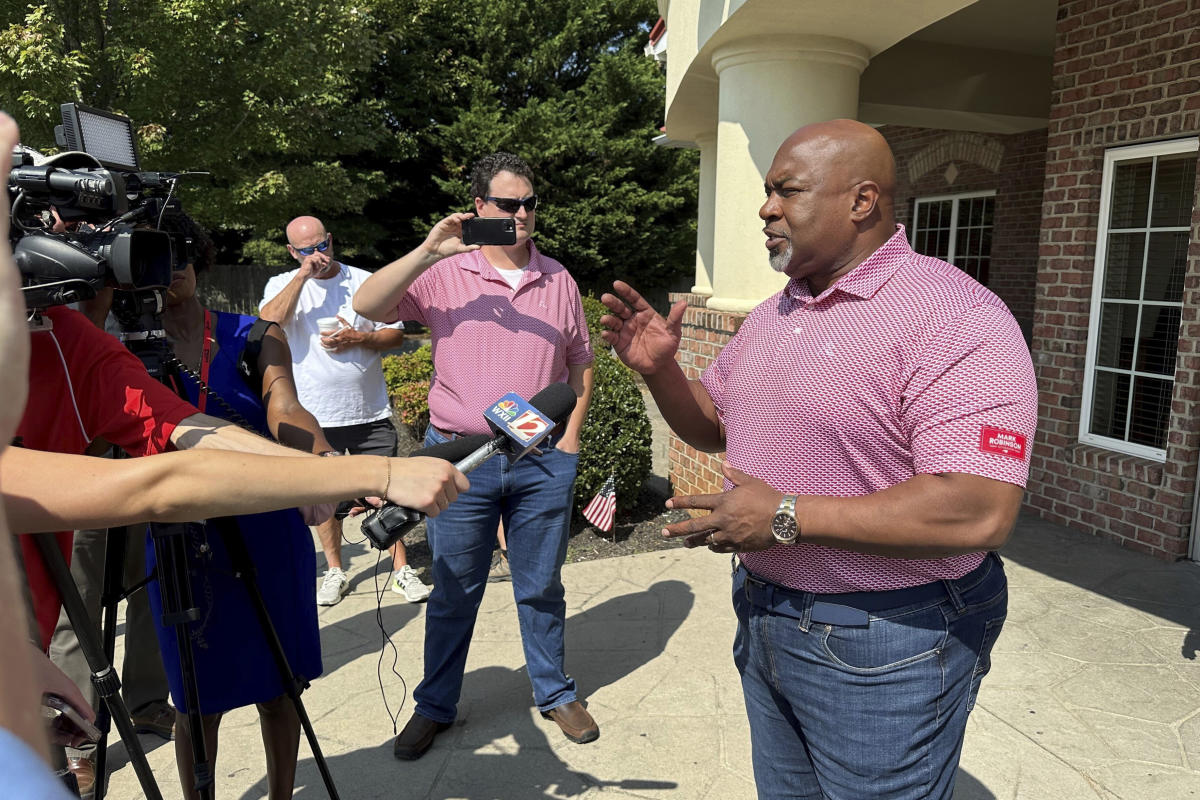The seven swing states that will decide the upcoming US election have received nearly half of the torrent of clean energy manufacturing dollars unleashed by a landmark 2022 climate bill, a new analysis shows, amid stuttering Democratic efforts to translate new factory jobs into political support.
Since the passage of clean energy incentives in the Inflation Reduction Act (IRA), a bill called the “most significant climate law in the history of mankind” by Joe Biden, nearly $150bn has been announced for a flurry of new American facilities producing electric cars, batteries and components for renewable energy.
Of this, $63bn, or nearly half, will flow to just seven states – Pennsylvania, Arizona, Georgia, Michigan, Nevada, North Carolina and Wisconsin – that form the battleground fought over by Kamala Harris and Donald Trump for November’s presidential election, bringing more than 50,000 new manufacturing jobs, according to an analysis carried out for the Guardian by Atlas Public Policy.
“The steady drumbeat of announcements over the past two years has been remarkable, and time and time again they are going to swing states,” said Tom Taylor, senior policy analyst at Atlas.
“The election will decide the fate of the Inflation Reduction Act and the election will be decided by the states that have benefitted the most from the manufacturing incentives in the law.”
Two years on, the IRA has delivered “the biggest US economic revolution in generations – and it’s all because America finally, finally decided to do something about climate change”, said Bob Keefe, executive director of E2, a non-partisan business group.
Nearly half a trillion dollars in total public and private investment, when deployment of wind and solar farms is included, has occurred nationally, creating more than 300,000 new jobs. Clean energy now accounts for more than half of total US private investment growth, while jobs in the industry are multiplying at double the rate of the overall American economy.
“We thought it would be a big step forward on clean energy, but honestly we never understood how quickly it would turn into a game changer,” said Gina McCarthy, who was Biden’s top climate advisor when the IRA was passed. “It’s flipped the climate conversation on its head. It’s been a remarkable success.”
Yet despite this green boom being centered upon some of the most politically contested parts of the US, there is little evidence the IRA is set to deliver electorally for Democrats. The swing states remain on a knife-edge between Harris, who cast the tie-breaking vote to pass the bill but barely mentions it while campaigning, and Trump, who has called it a “green scam” and vowed to abolish its spending.
Only four in 10 American voters have even heard anything much about the IRA, polling has shown, with a minority of voters expressing any confidence it will aid the economy, their families or them personally. “Most people don’t even know about it, so clearly there’s a communication problem, they’ve just not done a good job on that,” said Anthony Leiserowitz, an expert in public climate opinion at Yale University.
Leiserowitz said it’s “remarkable” only 49% of liberal Democrats, those most concerned about the climate crisis, have heard of the IRA, highlighting the struggles in selling a wonky tome of tax credits amid a fevered news cycle that lurches from one eye-popping crisis to the next.
Criticism has seeped into this vacuum – among major cable news channels in the past two years, half of all mentions of the IRA have been on Fox News, where it has been portrayed as wasteful and likened to far-left totalitarianism.
“Imagine if Trump had passed this,” said Leiserowitz. “He is a salesman, he made damn sure his signature was on those stimulus checks. Republicans are just much better at crowing about their successes than Democrats. There’s been a lack of focused messaging and the media is not inspired to do the job for them.”
Nadine Luci, a 60-year-old resident of Pennsylvania’s Rochester township who usually votes Democrat, worries about pollution and the climate but said she hasn’t “heard much at all” about the “Inflation Act”. In fact, she wasn’t even sure it had passed.
“I thought it was shut down a couple years ago by Republicans,” she said. “But if it goes through I think it would be a positive thing for Pennsylvania.”
When told the bill earmarked historic levels of funding for green technology, Luci said it sounded “really good”.
“We all could use it, everybody could use it,” said Luci. “But no, I haven’t heard much.”
Frustratingly for Democrats, this appears to be a trend. Leiserowitz’s polling has found that when voters are actually provided a description of the IRA an overwhelming three-quarters of them support it. “It’s just an enormous wasted opportunity,” he said.
Proclaiming the Inflation Reduction Act has been a challenge from its birth, which required assent from Joe Manchin, the coal baron senator and most conservative Democrat in Congress. It was bestowed a clumsy name that belies what it is – an enormous climate and energy bill with some healthcare add-ons – and has befuddled basic public recognition. “I wish I hadn’t called it that,” Biden lamented last year.
“It has been challenging because it’s technical in nature,” McCarthy said of the bill. “It’s been a little slow to energize people and for it to become a personal thing for people to grab onto. It’s a big bill but I do think we are beginning to see momentum gathering around it.”
The dense, 274-page bill outlines some Manchin-friendly measures controversial with environmental groups – mandated oil and gas drilling leases, dollops of cash for unproven carbon capture projects – but at its core was a shot of adrenaline to the heart of the climate movement and to an economy ravaged by Covid.
Uncapped tax credits for clean energy for the next decade that could top $1tn, grants for industrial emissions reduction, rebates for Americans to buy electric cars, incentives for people to get heat pumps or electric stoves at home – the IRA almost has it all in terms of support for clean energy, if not penalties for the fossil fuel pollution causing the climate crisis.
The benefits are set be profound. Goldman Sachs, which has said “so far at least, the reality is living up to or even exceeding expectations”, forecasts $3tn in clean energy spending as a result of the bill, with the US treasury coming up with an even more eye-watering figure – $5tn – in global economic benefits by 2050 from reduced carbon and air pollution.
Battery factories are sprouting in faded corners of St Louis, Missouri; Weirton, West Virginia; and in rural Georgia. At-risk auto manufacturing plants are being retooled for electric cars across eight states; a former paper mill in Lincoln, Maine, is being reimagined as a massive energy storage facility; solar farms are blanketing parts of Arizona and Texas and Indiana; clean aluminum production is starting in Kentucky and green steel in JD Vance’s Ohio hometown.
Many of the dozens of new projects are in “places where opportunity has left”, as Ali Zaidi, the White House climate adviser, has put it, with a vision of reinvigorated blue-collar towns helping the US close the gap on the clean energy powerhouse of China.
“We are already looking at it as a real pivotal moment,” said Dawn Lippert, chief executive of Elemental Impact, a non-profit investor in climate tech, who added that “our portfolio companies see extraordinary opportunity in rural areas of the US” because of their manufacturing history.
Politically, Republican rural and exurban areas have received the lion’s share of the spending, a fact that’s causing growing nervousness among some GOP members of Congress over the prospect of Trump reversing new job creation in their districts, even after they voted against it.
“It’s not tree-huggers and environmentalists in San Francisco or New York that are going to get hurt if the IRA is repealed,” said Keefe. “It’s working-class people in Georgia, Michigan and North Carolina that are going to get hurt because that’s where these these projects are going.”
If it survives intact over the next decade, the IRA could help create 9m new jobs, one analysis shows, while pushing down emissions 40% by 2030, putting the US within reach of its target to cut planet-heating polling in half by this point.
This progress is incremental and often invisible, though, with only a fraction of IRA funding already committed. In the former steel town of Weirton, West Virginia, for instance, many residents said they have not yet seen a resulting surge in the economy.
“We’ve been made a lot of promises here [that] haven’t been met,” said Dave, a retiree of the former Weirton steel mill in an interview at Dee Jay’s barbecue restaurant, adding he is “no fan” of Bidenomics or the Inflation Reduction Act.
Carol Hrabovsky, who owns Irish Pub, one of the only remaining bars on Weirton’s Main Street, said locals are still struggling with a lack of jobs and the high “price of everything”. Once a Democrat and now a Trump supporter, she said the IRA won’t convince her to vote for Biden, and she believes most of her neighbors feel the same.
“They shouldn’t have even called it the Inflation Reduction Act,” she said, adding that she is worried about Biden and Harris fostering “communism”.
Other lives are starting to be touched more positively – more than 3 million American families have already used tax credits to upgrade their homes with solar panels, heat pumps, water heaters or insulation, for example. The IRA may in time become a piece of the national furniture despite Republican hostility, much like Obamacare.
But can it help win Harris the election? Climate isn’t ranked as a leading priority by many voters, but Leiserowitz said there are opportunities within three climate-conscious groups that Harris badly needs in November – young people, people of color and suburban women. They could tip the balance in a close election.
“Those demographics do care about climate change and Harris needs to motivate them to get to the polls,” he said. “I don’t understand why they aren’t doing this. She has said that Trump thinks climate change is a hoax, which is a step in the right direction, but you need to connect the dots for people.”
Read more about the 2024 US election:
-
Election officials ‘look over our shoulders more’ as US political violence surges
-
Democrats campaign carefully after apparent Trump assassination plot
-
Why Republicans are raising double the money in down-ballot races

 German (DE)
German (DE)  English (US)
English (US)  Spanish (ES)
Spanish (ES)  French (FR)
French (FR)  Hindi (IN)
Hindi (IN)  Italian (IT)
Italian (IT)  Russian (RU)
Russian (RU)  3 hours ago
3 hours ago
























Comments